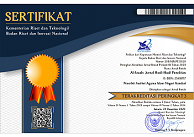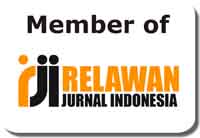Teaching About Female Genital Mutilation: Complex Question of Cultural Relativism and Preventive Movement
Abstract
Keywords
Full Text:
PDFReferences
Abdulcadir, Jasmine, Lucrezia Catania, Michelle Jane Hindin, Lale Say, Patrick Petignat, and Omar Abdulcadir. “Female Genital Mutilation.” Obstetrics and Gynecology, 2016. https://doi.org/10.1097/AOG.0000000000001686.
Alradie-Mohamed, Angi, Russell Kabir, and S. M.Yasir Arafat. “Decision-Making Process in Female Genital Mutilation: A Systematic Review.” International Journal of Environmental Research and Public Health, 2020. https://doi.org/10.3390/ijerph17103362.
Ameyaw, Edward Kwabena, Sanni Yaya, Abdul Aziz Seidu, Bright Opoku Ahinkorah, Linus Baatiema, and Carolyne Njue. “Do Educated Women in Sierra Leone Support Discontinuation of Female Genital Mutilation/Cutting? Evidence from the 2013 Demographic and Health Survey.” Reproductive Health, 2020. https://doi.org/10.1186/s12978-020-01027-1.
Awolola, Olalekan, and N. Ilupeju. “Female Genital Mutilation; Culture, Religion, and Medicalization, Where Do We Direct Our Searchlights for It Eradication: Nigeria as a Case Study.” Tzu Chi Medical Journal, 2019. https://doi.org/10.4103/tcmj.tcmj_127_18.
Azeze, Gedion Asnake, Anita Williams, Hannock Tweya, Mohammed Suleiman Obsa, Taklu Marama Mokonnon, Zewde Zema Kanche, Robera Olana Fite, and Anthony D. Harries. “Changing Prevalence and Factors Associated with Female Genital Mutilation in Ethiopia: Data from the 2000, 2005 and 2016 National Demographic Health Surveys.” PLoS ONE, 2020. https://doi.org/10.1371/journal.pone.0238495.
Benoni-Wang, Tabe J.O.E., and Vuyani S. Vellem. “A Womanist Theological Engagement of Triple Patriarchy and Its Implications on (Ejagham) Women’s Liberation.” HTS Teologiese Studies / Theological Studies, 2020. https://doi.org/10.4102/HTS.V76I1.5601.
Berg, Rigmor C., and Eva Denison. “Effectiveness of Interventions Designed to Prevent Female Genital Mutilation/Cutting: A Systematic Review.” Studies in Family Planning, 2012. https://doi.org/10.1111/j.1728-4465.2012.00311.x.
Best, Deborah L., and Kelsey L. Luvender. “Gender Development: Cultural Differences.” In International Encyclopedia of the Social & Behavioral Sciences: Second Edition, 2015. https://doi.org/10.1016/B978-0-08-097086-8.23211-X.
Bjalkander, O. “Female Genital Mutilation in Sierra Leone.” Female Genital Mutilation in Sierra Leone, 2013.
Bokaie, Mahshid, Zahra Bostani Khalesi, Nasibeh Roozbeh, and Shahnaz Mojahed. “Female Genital Mutilation in Southern Iran.” African Health Sciences, 2020. https://doi.org/10.4314/ahs.v20i2.16.
Danial, Sandra. “Cultural Relativism vs. Universalism: Female Genital Mutilation, Pragmatic Remedies.” The Journal of Historical Studies, 2013.
Emmenegger, Patrick, Jon Kvist, Paul Marx, and Klaus Petersen. “Three Worlds of Welfare Capitalism: The Making of a Classic.” Journal of European Social Policy, 2015. https://doi.org/10.1177/0958928714556966.
Erwanti, Marlinda Oktavia, Rahayu, and Elfia Farida. “Kajian Yuridis Female Genital Mutilation (FGM) Dalam Perspektif Hak Asasi Manusia.” DIPONEGORO LAW REVIEW, Volume 1, Nomor 4, Tahun 2012 1 (2012).
Erwanti, Marlinda Oktavia, Rahayu Rahayu, and Elfia Farida. “Kajian Yuridis Female Genital Mutilation (Fgm) Dalam Perspektif Hak Asasi Manusia (Studi Terhadap Praktik Female Genital Mutilation Di Indonesia.” Diponegoro Law Review 1, no. 4 (2012).
Evans, Ruth. “Teaching about Female Genital Mutilation/Cutting in Africa: Complex Questions of Culture, ‘Development’ and Human Rights.” Journal of Geography in Higher Education, 2020. https://doi.org/10.1080/03098265.2019.1661371.
Farida, Jauharotul, Misbah Zulfa Elizabeth, Moh Fauzi, Rusmadi Rusmadi, and Lilif Muallifatul Khorida Filasofa. “Sunat Pada Anak Perempuan (Khifadz) Dan Perlindungan Anak Perempuan di Indonesia: Studi Kasus Di Kabupaten Demak.” Sawwa: Jurnal Studi Gender, 2018. https://doi.org/10.21580/sa.v12i3.2086.
Fujiati, Danik. “Seksualitas Perempuan Dalam Budaya Patriarkhi.” Muwazah, 2016.
Gibeau, A. M. “Female Genital Mutilation: When a Cultural Practice Generates Clinical and Ethical Dilemmas.” Journal of Obstetric, Gynecologic, and Neonatal Nursing : JOGNN / NAACOG, 1998. https://doi.org/10.1111/j.1552-6909.1998.tb02595.x.
Hatch, E. Culture and Morality: The Relativity of Values in Anthropology. Columbia: University Press, 1983.
Hermanto, Agus. “Khitan Perempuan Antara Tradisi Dan Syari’ah.” KALAM, 2017. https://doi.org/10.24042/klm.v10i1.343.
Heryani, Neny, Herinawati Herinawati, and Diniyati Diniyati. “Tradisi Dan Persepsi Tentang Sunat Perempuan Di Desa Sukamaju Kabupaten Muaro Jambi.” Jambura Journal of Health Sciences and Research, 2020. https://doi.org/10.35971/jjhsr.v2i1.3811.
Hikmalisa, Hikmalisa. “Peran Keluarga Dalam Tradisi Sunat Perempuan di Desa Kuntu Kabupaten Kampar Provinsi Riau (Analisis Gender Sebagai Ketimpangan HAM Dalam Praktik Sunat Perempuan).” Musãwa Jurnal Studi Gender Dan Islam, 2016. https://doi.org/10.14421/musawa.2016.151.21-37.
Idrus, Nurul Ilmi. “Antropologi Feminis: Etnografi, Relasi Gender Dan Relativisme Budaya Di Indonesia.” Antropologi Indonesia 30, no. 3 (2014): 272–96. https://doi.org/10.7454/ai.v30i3.3568.
Lane, Sandra D., and Robert A. Rubinstein. “Judging the Other: Responding to Traditional Female Genital Surgeries.” The Hastings Center Report, 1996. https://doi.org/10.2307/3527930.
Mbanya, Vivian N., Laura Terragni, Abdi A. Gele, Esperanza Diaz, and Bernadette N. Kumar. “Barriers to Access to the Norwegian Healthcare System among Sub-Saharan African Immigrant Women Exposed to Female Genital Cutting.” PLoS ONE, 2020. https://doi.org/10.1371/journal.pone.0229770.
Muawanah, Siti, Menik Sri Daryanti, and Atik Triratnawati. “Aspek Budaya, Agama, Dan Medis Dari Praktik Sunat Anak Perempuan Di Desa Di Jawa Tengah.” BKM Journal of Community Medicine and Public Health 34, no. 9 (2018): 329–36.
Mustaqim, Muhamad. “Konstruksi Dan Reproduksi Budaya Khitan Perempuan: Pergulatan Antara Tradisi, Keberagamaan Dan Kekerasan Seksual Di Jawa.” PALASTREN Jurnal Studi Gender 6, no. 1 (2016): 89–106.
Nurdiyana, Tutung. “Sunat Perempuan pada Masyarakat Banjar di Kota Banjarmasin.” Komunitas: International Journal of Indonesian Society and Culture, 2013. https://doi.org/10.15294/komunitas.v2i2.2281.
Obiora, Oluchukwu Loveth, Johanna Elizabeth Maree, and Nokuthula Nkosi-Mafutha. “Female Genital Mutilation in Africa: Scoping the Landscape of Evidence.” International Journal of Africa Nursing Sciences, 2020. https://doi.org/10.1016/j.ijans.2019.100189.
Oktarina. “Permenkes Sunat Kaum Perempuan : Pro Dan Kontra Antara.” Jurnal Manajemen Pelayanan Kesehatan 14, no. 04 (2011): 177–80.
Pabbajah, Mustaqim, Irwan Abdullah, Hasse Jubba, M. Taufiq Hidayat Pabbajah, and Zainal Said. “Pilgrimage to Bawakaraeng Mountain among the Bugis-Makassar in Indonesia: A Contestation between Islamic Identity and Local Tradition.” International Journal of Religious Tourism and Pilgrimage, 2021.
Rachels, J. Filsafat Moral. PT Kanisius, 2014.
Reisel, Dan, and Sarah M. Creighton. “Long Term Health Consequences of Female Genital Mutilation (FGM).” Maturitas, 2015. https://doi.org/10.1016/j.maturitas.2014.10.009.
Rokhmah, Islamiyatur, and Umu Hani Edi Nawangsih. “Sunat Perempuan Dalam Perspektif Budaya, Agama dan Kesehatan (Studi Kasus di Masyarakat Desa Baddui Kecamatan Galesong Kabupaten Takalar Sulawesi Selatan).” Jurnal Kebidanan Dan Keperawatan Aisyiyah, 2016. https://doi.org/10.31101/jkk.85.
Ross, Cody T., Pontus Strimling, Karen Paige Ericksen, Patrik Lindenfors, and Monique Borgerhoff Mulder. “The Origins and Maintenance of Female Genital Modification across Africa: Bayesian Phylogenetic Modeling of Cultural Evolution under the Influence of Selection.” Human Nature, 2016. https://doi.org/10.1007/s12110-015-9244-5.
Rushwan, Hamid. “Female Genital Mutilation: A Tragedy for Women’s Reproductive Health.” African Journal of Urology, 2013. https://doi.org/10.1016/j.afju.2013.03.002.
Waigwa, Susan, Lucy Doos, Caroline Bradbury-Jones, and Julie Taylor. “Effectiveness of Health Education as an Intervention Designed to Prevent Female Genital Mutilation/Cutting (FGM/C): A Systematic Review.” Reproductive Health, 2018. https://doi.org/10.1186/s12978-018-0503-x.
Wondwossen Fantaye, Arone, and Anne T.M. Konkle. “Social Media Representation of Female Genital Cutting: A YouTube Analysis.” Women’s Health, 2020. https://doi.org/10.1177/1745506520949732.
Yount, Kathryn M., Yuk Fai Cheong, Rose Grace Grose, and Sarah R. Hayford. “Community Gender Systems and a Daughter’s Risk of Female Genital Mutilation/Cutting: Multilevel Findings from Egypt.” PLoS ONE, 2020. https://doi.org/10.1371/journal.pone.0229917.
———. “Community Gender Systems and a Daughter’s Risk of Female Genital Mutilation/Cutting: Multilevel Findings from Egypt.” PLoS ONE 15, no. 3 (2020): 1–24. https://doi.org/10.1371/journal.pone.0229917
DOI: http://dx.doi.org/10.31332/ai.v0i0.3357
Copyright (c) 2021 Nur Quma Laila, Hasse J

This work is licensed under a Creative Commons Attribution-NonCommercial-ShareAlike 4.0 International License.










